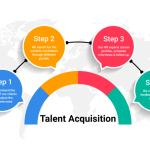Gone are the days when the workplace was a physical space where employees would occupy for the conventional nine-to-five shifts. 21st-century companies are looking for better ways to connect clients with the office and each other in a bid to enhance productivity and agility in an increasingly competitive corporate world.
To reflect this changing work experience with better accuracy, the digital workplace has become the go-to solution for many modern companies with huge workforces.
Employers can take technologies used at the workplace by employees, such as environmental controls, email, virtual meeting tech, workflow and management tools, etc. and integrate them with a sensor-enabled setting to create a more efficient connection between employees for enhanced communication and easier use of the physical workplace.
Being a fairly new concept to many companies, they have been adopted quicker within digital companies like Caffeinated Projects who have a talented but disparate workforce.
Digital workplaces may prove too taxing to create and hard to make the most of. Discussed below are the factors you need to focus on as you look to smoothly migrate to a digital workplace.
Table of Contents
Identify your objectives
Integrating your physical workplace with a digital workplace can be costly and it is only right that you know why you are doing it in the first place and how it is going to fall in line with your business goals and objectives.
The main goal of creating a digital workplace, of course, is to increase the connection between employees and enhance teamwork and productivity. Ensure heads of your company’s main departments such as the human resource department are involved to avoid compromising long term organization and department goals.
Most of the time, digital workplaces will necessitate retrenchments so it is wise that you work closely with the HR department to see how you are going to make optimum use of the workers in your payroll.
Create a blueprint
Next, you will need to create a plan to integrate elements of the digital workplace concept into marketing, sales, manufacturing, IT, customer support, and HR. Your blueprint should be tailored to answer questions such as how you are going to use the planned technologies to increase engagement levels within and between departments.
This is perhaps the most important stage of your migration to a digital workplace. Different companies work differently and you need to study your industry and come up with a strategy that jibes with what you do, who you serve, the number of employees in your company, and what each of them does.
Take employee experience into account
According to studies, employees who are involved in company decisions are more likely to be productive than their counterparts who have to implement employer plans and decisions that they were not involved in making.
Since your employees are at the center of the digital workplace initiative, it is important to show them your blueprint and ask for their honest opinions. The idea is to find the perfect balance of connectivity, productivity, and employee satisfaction.
Incorporate the most relevant employee concerns in your plans and make a point to explain to your employees why some of their opinions could not be considered.
Possible change in qualification requirements
Migration to digital workplaces can result in significant changes in management, internal processes, incentives, culture, departmental structures, and behavior. Most importantly, you will need people who have the skills to coordinate digital workplaces.
This can be achieved by hiring new employees or training some of your own workers to equip them with the skills needed to work in a digital workplace and coordinate the rest of the workforce. If there will be any major organizational changes to brace for, ensure your heads of departments know about it right from the beginning.
Account for potential change in processes
There is a high possibility you will have to adjust your company’s processes to align them with the requirements of the digital workplace. You can, for instance, study worker movements in the physical workplace and try to identify the things they do often and how they like their workplace in terms of lighting, heating, and office arrangements.
As per Newsgram, a sensor-enabled building can help you track employees in this manner while technologies such as internet of things (IoT) and artificial intelligence can be useful in automating routine processes such as lighting. The fewer workers are involved in non-production activities such as switching heating systems on and off, the more productive they are likely to be.
Work to improve information sharing
The point of incorporating a digital workplace into your physical workplace is to ensure workers don’t struggle to execute simple office tasks and are instead focused on their jobs. If you can’t ease the hassle of file sharing between employees, then you are far from making the most of your digital workplace.
Smartphones and tablets have made document sharing extremely easy, so this should provide a benchmark against which the success of your plan is to be measured. Make it easy for any employee to reach a colleague without sending notifications to the rest of the office.
This way, once a notification is received in an employee’s computer, they will know it is meant specifically for them and will be quick to check it. The other workers, on the other hand, will not have to take unnecessary breaks from what they are doing to respond to irrelevant alarms.
Employees will also appreciate getting what they want when they want it without bothering colleagues. This can be achieved by making it possible for shared files and documents to be kept in places where they can be accessed by every worker.








